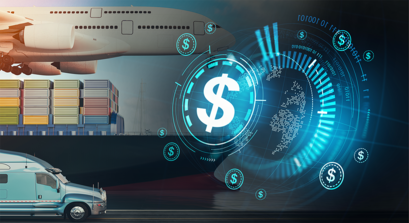The World Economic Forum just came out with a declaration that the future of Global Trade is TradeTech, playing off of the term FinTech for the financial markets. Well, it is certainly hard for us to argue with their statement. Integrated, cloud-based, inter-connected platforms will continue to address the failure points where manual administration of the supply chain fails.
As the Global Trade landscape continually evolves, businesses are tasked with navigating intricate waters, especially in the realms of pricing and cost management. Two concepts that once buzzed in the industry, and are now making a notable resurgence, are auto-rating and auto-costing. These twin pillars, pivotal in ensuring accuracy, speed, and efficiency in the trade ecosystem, are expected to play a central role in addressing the imminent challenges facing major ocean markets. But why are they regaining attention now, and how are they relevant in the current trade scenario? Let’s dive deeper into the significance of these terms and their role in shaping the future of global trade.
Challenges Looming Over Major Ocean Markets
The major ocean markets are about to see another round of disruption that will pose challenges to the trade participants. This time the issue is going to center on rates and not congestion, but the issues and solution tools will remain the same. An enormous number of new vessels are about to begin coming online and the competition to fill these new ships is going to be tremendous. The challenge will be in administering the large number of rapid changes magnified by the still considerable quantities of shipments moving in these major trade lanes.
Questions Arising for Different Players
Given these challenges, what does it mean if you are involved in global trade? If you are a BCO, how do you ensure that the rates you negotiated are, in fact, the rates you are invoiced? If you are a carrier or an NVOCC / Forwarder, how do you ensure that all of the origins know what to charge your clients? NVOCCs / Forwarders have the added challenge of communicating to their origins which carrier, and which service, to route the shipments on as they compete with each other to gain and/or maintain business and are negotiating rates as if they were trading stock on a trading floor. Routing shipments can be the difference for the NVOCC / Forwarder between making money on a shipment and losing money on a shipment but making it up with volume! If the new pricing quoted to a customer is based on carrier A but origin routes on carrier B, then all bets are off on making a profit.
Navigating the Waters of Capacity Control
This will be further exacerbated by an anticipated large number of blank sailings as carriers strive to keep some semblance of capacity control in the market in order to relieve pressure on the market pricing. So, in the example above, Carrier A is cheaper, but they are not sailing this week and the customer has cargo that needs to move, so what will the pricing be for Carrier B?
The Resurgence of Auto-Rating and Auto-Costing
It has been a long time since there was much discussion on Auto-Rating and Auto-Costing but that does not mean that the need for these functions has gone away. This was a major topic of marketing in the late 1990s with terms such as Quotes-to-Cash but the technological foundations to enable this process were elusive. This is where an integrated supply platform shines.
Steps Towards Integration
Step 1: All users need to be working on the same system in real-time. This includes Sales and Pricing as well as Operations, particularly at Origin.
Step 2: The system needs to be integrated so that the Sales and Pricing process is immediately visible to the Operations users and/or the Shipper so that the results of the negotiations transpiring all over the world in real-time can be actioned the very next moment.
What Can Be Learnt from FinTech?
Can you imagine the chaos in the Financial Markets if the pricing agreed to by the traders on the floor were not the prices on the trades when the transaction was made? That is where FinTech has enabled the steady and rapid expansion of the financial markets over the past 30 years.
The issue for Global Trade is much more challenging because the “Traders” (Sales and Pricing staff) are often located at different points around the world from where the transaction (shipment) will originate and be accounted for. The challenge is massive and the volume of transactions and the rate of change is going to be enormous; far more than human processes can maintain and that failure will create its own set of cascading failure points. Markets are not nice when their needs are not met.
We can expect to see resistance to expanding production (and therefore Global Trade) out of current sources because doing so becomes more than what can be handled easily and accurately, and globalization slows as a result. At the same time, new markets may be slow to emerge and lower demand for exports will result for the same reasons. And, we can expect to see financial problems for a full range of trade participants as these failures impact their bottom lines.
The Silver Lining: TradeTech Advancements
At the same time, there will be opportunities for those who address the challenges with new technology. This is where TradeTech – technology for Global Trade – comes in. Auto-Rating and Auto-Costing will be both a strategic advantage ensuring that their operators are always in sync with the market changes and a commercial advantage as carriers and NVOCCs/Forwarders demonstrate to their customers their ability to administer a roiling market with consistent and predictable outcomes. BCOs will have the assurance that they can continue to expand their product sourcing and the corresponding costing advantages will give them commercial advantages on the market shelves and e-commerce pages.
In Conclusion
TradeTech becomes that machine that leverages human actions to achieve ever greater productivity and with all new technology changes, there will be strategic rewards for those that are early adaptors.
At Trade Tech (the company), we recognize the importance of these innovations and their potential to reshape trade as we know it. We work with BCOs, carriers, and forwarders to embrace these tools to remain competitive, accurate, and agile in this dynamic landscape. Reach out to our team today to understand how our integrated solutions can empower your business operations, ensuring that you’re not just adapting to the future but shaping it.



